601
The terrible price fashion
Canada opens the annual season of the seal hunt, despite a wave of protests held around the world. Animal rights activists are outraged by the brutal murder of these animals, hides and fur which is used in the fashion industry. The life of the collar on the neck ladies - is it worth it?
Attention! Under the cat with a weak nervous system and thin-skinned psyche better not to go, a lot of unflattering photos ...
9 unpleasant ph via animalpicture
[next]
1. Hunter beats harp seal (harp seal) on the first day of the season of the Canadian seal hunt in 2010, April 8 off the coast of Newfoundland. The seal hunt is a lot of controversy. Animal rights activists believe that it is unnecessarily cruel, poorly monitored and does not bring any benefits. Hunters and Canadian authorities say that allowing hunting to feed isolated from the world community. (Stewart Cook / International Fund For Animal Welfare)

2. The body of a baby harp seal lies on the banks of the St. Lawrence. Poor ice conditions led to an increase in mortality of seals this year. Canada signed the permission to kill 330,000 harp seal in 2010, which is 50,000 more than last year. However, poor ice conditions and weak demand for seal pelts is likely to lead to the fact that production this year will be poorer than usual. (Stewart Cook / IFAW)
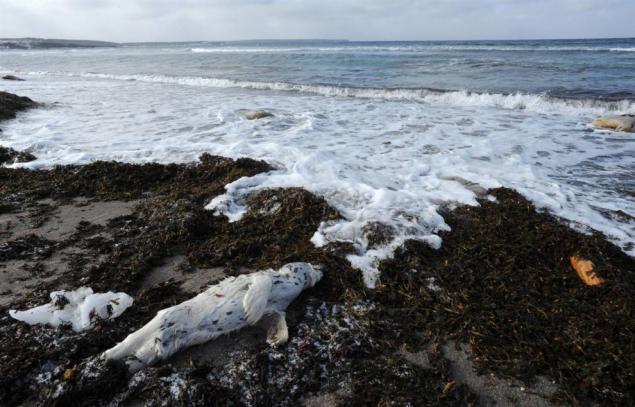
3. Drifting ice - an excellent place for rearing. But this season an adult harp seal increasingly have to go further north to find a good ice. (Stewart Cook / IFAW)
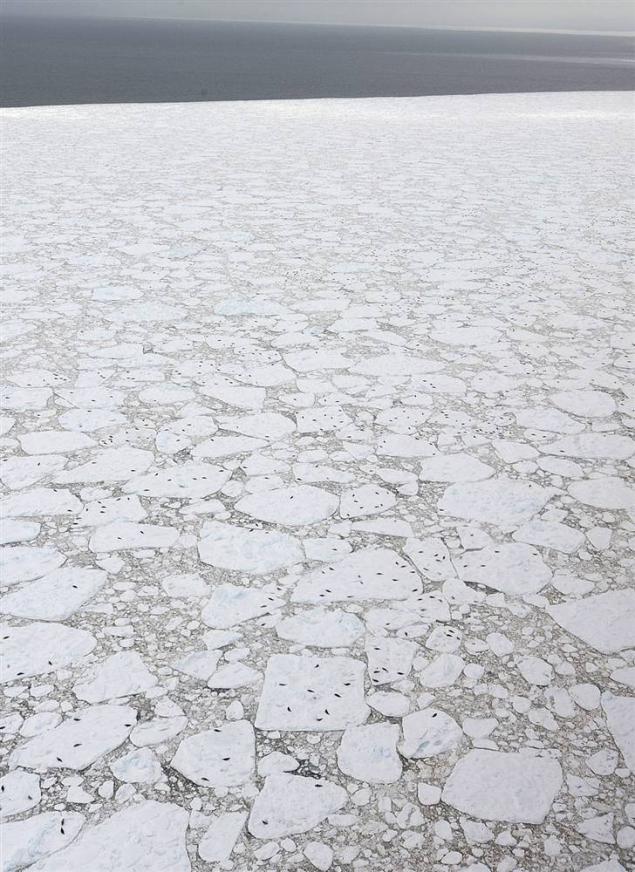
4. Since 1987, hunters are not allowed to kill young seals, which are not yet oblinyali that usually occurs between 10 to 21 days. Canada estimates the total number of harp seals 7 million. In the 1970s, there were about 1, 8 million. (Paul Darrow / Reuters)
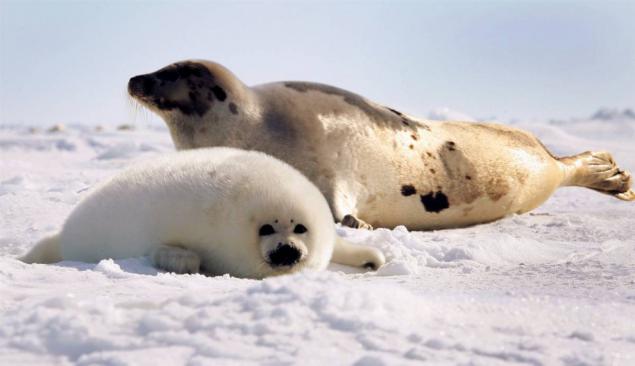
5. The annual seal hunting season, which hosts Canada, causing a wave of protests around the world, including this one, which took place on March 15 in Barcelona. Animal rights smeared with paint and lay down in front of the Canadian Chamber of Commerce, representing the seals killed. (Manu Fernandez / AP)
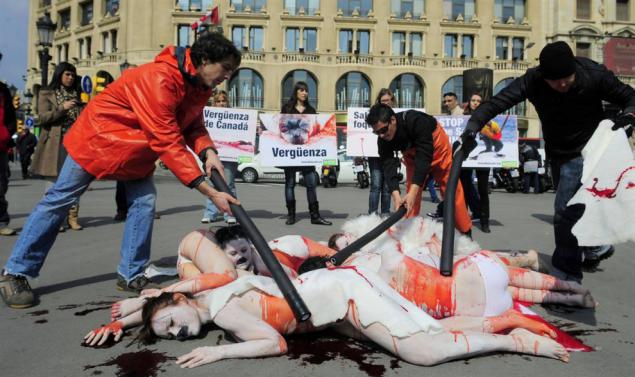
6. Corpses filled ice harp seal during a commercial hunt, 2009. Canada believes that profit from such a hunt gets about 6,000 people. (Andrew Vaughan / Associated Press)

7. Hunters sealskin pelts harvested in the Gulf of St. Lawrence during the 2009 hunting season usually seal pelts used in the fashion industry in Norway, Russia, and recently also in China. Last year the average price per pelt was $ 14, whereas in 2007 they were estimated at $ 52 apiece. (Andrew Vaughan / The Canadian Press)
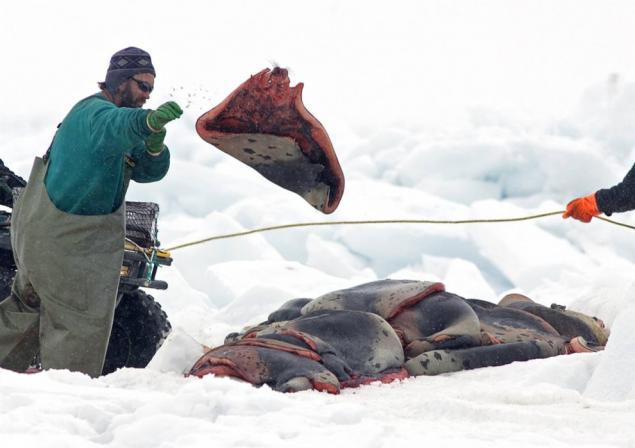
8. Canada is struggling to support the seal hunt industry for commercial purposes. Recently, the country has sponsored a booth at the International Fur and Leather Exhibition in Beijing. "Our government unite all forces to support the thousands of hunters, whose lives depend on the sale of seal pelts" - do not hesitate, the minister said the fishing industry in Canada Gail Shea. (Andy Wong / AP)
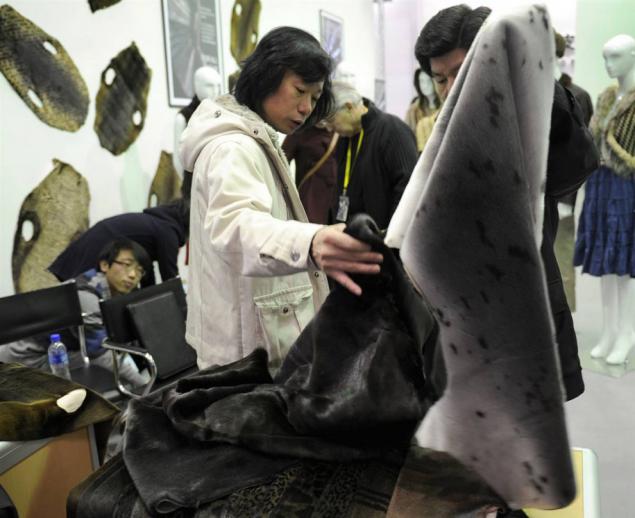
9. The seal hunt is supported by many Canadian legislators. They often go to the restaurant on Parliament Hill in Ottawa, where the whole week on the menu only seal meat - in support of the seal hunters. The EU, in turn, has banned the import and export of any goods related to seals, including meat, skin, organs and seal oil, which is used in the manufacture of some medicines. (Fred Chartrand / The Canadian Press via AP)

Source:
Attention! Under the cat with a weak nervous system and thin-skinned psyche better not to go, a lot of unflattering photos ...
9 unpleasant ph via animalpicture
[next]
1. Hunter beats harp seal (harp seal) on the first day of the season of the Canadian seal hunt in 2010, April 8 off the coast of Newfoundland. The seal hunt is a lot of controversy. Animal rights activists believe that it is unnecessarily cruel, poorly monitored and does not bring any benefits. Hunters and Canadian authorities say that allowing hunting to feed isolated from the world community. (Stewart Cook / International Fund For Animal Welfare)

2. The body of a baby harp seal lies on the banks of the St. Lawrence. Poor ice conditions led to an increase in mortality of seals this year. Canada signed the permission to kill 330,000 harp seal in 2010, which is 50,000 more than last year. However, poor ice conditions and weak demand for seal pelts is likely to lead to the fact that production this year will be poorer than usual. (Stewart Cook / IFAW)

3. Drifting ice - an excellent place for rearing. But this season an adult harp seal increasingly have to go further north to find a good ice. (Stewart Cook / IFAW)

4. Since 1987, hunters are not allowed to kill young seals, which are not yet oblinyali that usually occurs between 10 to 21 days. Canada estimates the total number of harp seals 7 million. In the 1970s, there were about 1, 8 million. (Paul Darrow / Reuters)

5. The annual seal hunting season, which hosts Canada, causing a wave of protests around the world, including this one, which took place on March 15 in Barcelona. Animal rights smeared with paint and lay down in front of the Canadian Chamber of Commerce, representing the seals killed. (Manu Fernandez / AP)

6. Corpses filled ice harp seal during a commercial hunt, 2009. Canada believes that profit from such a hunt gets about 6,000 people. (Andrew Vaughan / Associated Press)

7. Hunters sealskin pelts harvested in the Gulf of St. Lawrence during the 2009 hunting season usually seal pelts used in the fashion industry in Norway, Russia, and recently also in China. Last year the average price per pelt was $ 14, whereas in 2007 they were estimated at $ 52 apiece. (Andrew Vaughan / The Canadian Press)

8. Canada is struggling to support the seal hunt industry for commercial purposes. Recently, the country has sponsored a booth at the International Fur and Leather Exhibition in Beijing. "Our government unite all forces to support the thousands of hunters, whose lives depend on the sale of seal pelts" - do not hesitate, the minister said the fishing industry in Canada Gail Shea. (Andy Wong / AP)

9. The seal hunt is supported by many Canadian legislators. They often go to the restaurant on Parliament Hill in Ottawa, where the whole week on the menu only seal meat - in support of the seal hunters. The EU, in turn, has banned the import and export of any goods related to seals, including meat, skin, organs and seal oil, which is used in the manufacture of some medicines. (Fred Chartrand / The Canadian Press via AP)

Source:
























